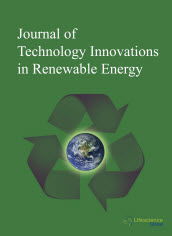jtire
|
|
|
Abstract: The State of California’s renewable energy policies and energy incentives are the main drivers of renewable generation development occurring in the Pacific Northwest. The largest wind integration efforts are happening within the Bonneville Power Administration’s (BPA) Balancing Area (BA). BPA is approaching a 40 percent wind penetration factor. Such a large wind penetration imposes significant challenges on the transmission system operation requiring more system studies in operational time frame. These challenges include needs for additional voltage regulation requiring more switching operations, dealing with higher ramping rates and carrying additional regulation reserve as well as additional difficulty in Columbia River management (river scheduling). This paper discus some of those challenges in more details. Keywords: Bonneville Power Administration (BPA), Balancing Area (BA), System Operating limits (SOL), Transmission System Operation, Wind Penetration..Download Full Article |
|
|
|
Abstract: This paper proposes an optimized model of a variable speed wind turbine equipped with permanent magnet synchronous generator (VSWT-PMSG) which also has been used for the stability augmentation of a wind farm including fixed speed wind generators, like Induction generator (IG). An effective control strategy with two-level IGBT converter-inverter set along with DC link capacitor and maximum power point tracking (MPPT) system assures the real power exchange to the grid and also a perfect reactive power compensation that maintains the grid side voltage constant. Moreover, it is shown that the proposed model can enhance the stability of a conventional IG based wind farm when used in combination with PMSG. Thus it eliminates the need of external controlling devices and makes the system simple and cost effective. A comparison for the stability augmentation capability between IG and PMSG has been explained. Both the dynamic and transient analyses of the proposed system have been carried out by using the laboratory standard power system software package, PSCAD/EMTDC. Keywords: Reactive power compensation, IG, frequency converter, dynamic stability and transient stability.Download Full Article |
|
|
|
Abstract: Bioaugmented fermentation of cellulosic substrates to produce biohydrogen via co-culture of isolated strains was investigated. Two mesophilic anaerobic bacterial strains, known for their ability to hydrolyze cellulosic substrates, were taken in consideration: Shigella flexneri str. G3, which shows high cellulolytic activity but cannot ferment oligosaccharides to bioenergy, and Clostridium acetobutylicum X9, able to convert microcrystalline cellulose into hydrogen. The ability of the selected strains to effectively convert different cellulosic substrates to hydrogen was tested on carboxymethyl cellulose (AVICEL), as well as pretreated lignocellulosic material such as Bermuda grass, corn stover, rice straw, and corn cob. Results showed that co-culture of Shigella flexneri str G3 and Clostridium acetobutylicum X9 efficiently improved cellulose hydrolysis and subsequent hydrogen production from carboxymethyl cellulose. Hydrogen production yield was enhanced from 0.65 mol H2 (mol glucose)−1 of the X9 single culture to approximately 1.5 mol H2 (mol glucose)−1 of the co-culture, while the cellulose degradationefficiency increased from 50% to 95%. Co-culture also efficiently improved hydrogen production from natural lignocellulosic materials (which was up to 4-5 times higher than mono-culture with X9), with the highest performance of 24.8 mmol L-1 obtained on Bermuda grass. The results demonstrate that co-culture of S. flexneri G3 and C. acetobutylicum X9 was capable of efficiently enhance cellulose conversion to hydrogen, thus fostering potential biofuel applications under mesophilic conditions. Keywords: Bioaugmentation, co-culture, lignocelluloses, saccharification, biohydrogen.Download Full Article |
|
|
|
Abstract: The brushless doubly fed induction generator (BDFIG) has the potential to be employed as a variable speed wind turbine generator. Owing to brushless configuration of this generator, its reliability is higher than DFIG. Most of the grid faults are unsymmetrical. Hence, this paper analyzes dynamic behavior of BDFIG under symmetrical and unsymmetrical faults and presents dynamic models for both fault types. In order to validate the results of analysis, simulations have been carried out using MATLAB/Simulink software. Then, the control winding (CW) current is compared under symmetrical and unsymmetrical faults. Keywords: Brushless doubly fed induction generator (BDFIG), Grid faults, Rotor speed, Dynamic modeling, Current winding.Download Full Article |
|
|
|
Abstract: An accurate solar tracker matches array angles with solar angles throughout the day. Many studies have used the power produced by a tracked PV array as a proxy to characterize a tracker’s accuracy. However, it is difficult to decouple the effects of tracker performance from other effects on power output. It was not found in the literature reviewed that there are studies that determine the accuracy of solar trackers by directly measuring the tracker angles. This study was an experiment to determine the accuracy of two small commercially available non-algorithm based solar trackers: the Zomeworks UTR-020 passive one axis solar tracker, and the Wattsun AZ-225 active electro-optical two axis solar tracker. Accuracy of the trackers was determined by measuring the tracking angles under varying conditions including direct beam irradiation (DBI) and global horizontal irradiance (GHI), and comparing to calculated sun angles. The results showed that the average azimuth angle accuracy of the Zomeworks UTR-020 is 75%, the average azimuth angle accuracy of the Wattsun AZ-225 is 88%, and the average elevation angle accuracy of the Wattsun is 89%. In addition, the results showed a weak correlation between the azimuth accuracy of the Zomeworks and DBF, a strong correlation between the azimuth accuracy of the Wattsun and DBF, and a moderate correlation between the elevation accuracy of the Wattsun and DBF. Moreover, the azimuth accuracy of the Wattsun was always higher than that of the Zomeworks under all DBF and GHI conditions. Keywords: Solar Tracker, Accuracy, Tracking Error, Non Algorithm Based, Solar Tracking Angles.Download Full Article |


